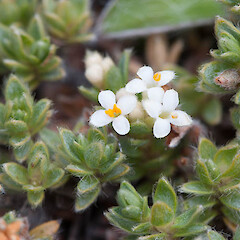Pimelea mesoa subsp. mesoa
Common name
pimelea
Synonyms
None (first described in 2011)
Family
Thymelaeaceae
Flora category
Vascular – Native
Endemic taxon
Yes
Endemic genus
No
Endemic family
No
Structural class
Trees & Shrubs - Dicotyledons
NVS code
The National Vegetation Survey (NVS) Databank is a physical archive and electronic databank containing records of over 94,000 vegetation survey plots - including data from over 19,000 permanent plots. NVS maintains a standard set of species code abbreviations that correspond to standard scientific plant names from the Ngä Tipu o Aotearoa - New Zealand Plants database.
PIMMSM
Chromosome number
2n = 36
Current conservation status
The conservation status of all known New Zealand vascular plant taxa at the rank of species and below were reassessed in 2017 using the New Zealand Threat Classification System (NZTCS) – more information about this can be found on the NZTCS website. This report includes a statistical summary and brief notes on changes since 2012 and replaces all previous NZTCS lists for vascular plants.
Please note, threat classifications are often suggested by authors when publications fall between NZTCS assessment periods – an interim threat classification status has not been assessed by the NZTCS panel.
- Conservation status of New Zealand indigenous vascular plants, 2017 . 2018. Peter J. de Lange, Jeremy R. Rolfe, John W. Barkla, Shannel P. Courtney, Paul D. Champion, Leon R. Perrie, Sarah M. Beadel, Kerry A. Ford, Ilse Breitwieser, Ines Schönberger, Rowan Hindmarsh-Walls, Peter B. Heenan and Kate Ladley. Department of Conservation. Source: NZTCS and licensed by DOC for reuse under the Creative Commons Attribution 4.0 International licence.
2017 | Not Threatened | Qualifiers: DP
Previous conservation statuses
2012 | Not Threatened | Qualifiers: DP
2009 | Data Deficient
Brief description
Low shrub to 10cm tall bearing pairs of blueish-green pointed leaves that are hairy underneath and with hairy white flowers and orange fruit inhabiting valleys in the vicinity of Marlborough and north Canterbury. Leaves 4.5-7mm long by 1.8-2.5mm wide.
Distribution
Endemic. New Zealand: South Island (intermontane basins and adjacent river flats of the upper Wairau, Clarence and Awatere to the Waiau-uha, Hurunui and Waimakariri
Habitat
Montane to alpine. A common species of intermontane basins and their associated river flats and alluvial terraces. Pimelea mesoa subsp. mesoa is mostly found within short tussock grassland where it commonly grows amongst Poa colensoi, Festuca novae-zelandiae, Raoulia spp. It also occasionally grows in open shrubland.
Detailed description
A small much-branched, suberect, or decumbent, sometimes appressed, shortly branched compact shrub fomring ± circular patches up to 200 mm diameter. Branching mainly sympodial, branches radiating from a stout main stem. Branches of young stems dark brown, moderately to densely covered with long grey-white or yellowish hairs, internodes 0.5–2.5 mm long. Older stems stout (to 10 mm), black, glabrate to glabrous. Node buttresses lunate to elongate, brown, prominent on leafless stems. Leaves decussate, ascending tightly imbricate, becoming patent, on short (0.3-0.5 mm) reddish petioles. Lamina 4.5-7.0 × 1.8-2.5 mm, dull glaucous-green, elliptic, broad-elliptic or oblong, sometimes ovate, slightly adaxially concave, mid-vein obscure; tip obtuse; base cuneate; abaxial surface moderately densely covered with long, straight or curled hairs; stomata on both adaxial and abaxial leaf surfaces. Inflorescences terminal, 4-12-flowered; involucral bracts 4, wider than ordinary leaves (6-8 × 3-4 mm). Receptacles densely hairy. Plants gynodioecious. Flowers white, scented, on short (0.2 mm) pedicels, very hairy outside, inside hairless. Female tube 3-4 mm long, ovary portion 2 mm, calyx lobes 2 × 1 mm; hermaphrodite tube 5-6 mm long, ovary portion 1.5 mm, calyx lobes 3 × 1.5 mm. Anther dehiscence introrse. Ovary with sparse short hairs on apex. Fruits ovoid, fleshy, yellow to orange 4.0-5.0 × 2.0-3.2 mm. Seeds 2.5 × 1.3 mm.
Similar taxa
Pimelea mesoa has been confused in the past with Pimelea sericeovillosa from which it differs by its larger size, upright or elongate, prostrate stems, larger, adaxially glabrous leaves and larger, more numerous flowers. From P. oreophila with which it often grows, it can be distinguished by the abaxially densely hairy leaf surface and by the obtuse leaf tips. Pimelea mesoa subsp. macra differs from subsp. mesoa by its more slender root stock, procumbent laxer growth habit, longer non-radiating stems, longer internodes (2.0-5.0 mm cf. 0.5-2.5 mm in subsp. mesoa) less tightly imbricating and lax leaf arrangement.
Flowering
September - February
Flower colours
White
Fruiting
Unknown
Propagation technique
Unknown. Probably easily grown from semi-hard and hardwood cuttings.
Threats
Probably not threatened. However, some populations are small and are possibly threatened by competition from hawkweeds (Pilosella spp.). However as Pimelea mesoa subsp. meosa was not assessed by Burrows (2011) using the New Zealand Threat Classification Manual (Townsend et al. 2008) it has no valid threat assessment. So at this stage it seems best to recommend an interim threat assessment of “Data Deficient”.
Etymology
pimelea: Pimeleoides means “resembling Pimelea’’, a genus in the family Thymelaeaceae (Greek, -oides = resembling, like).
Where to Buy
Not commercially available.
Attribution
Fact Sheet Prepared for NZPCN by: P.J. de Lange (30 April 2011) adapted from Burrows (2011).
References and further reading
Burrows, C.J. 2011: Genus Pimelea (Thymelaeaceae) in New Zealand 4. The taxonomic treatment of ten endemic abaxially hairy-leaved species. New Zealand Journal of Botany 49: 41–106.
de Lange, P.J.; Norton, D.A.; Courtney, S.P.; Heenan, P.B.; Barkla, J.W.; Cameron, E.K.; Hitchmough, R.; Townsend, A.J. 2009: Threatened and uncommon plants of New Zealand (2008 revision). New Zealand Journal of Botany 47: 61-96.
NZPCN Fact Sheet citation
Please cite as: de Lange, P.J. (Year at time of access): Pimelea mesoa subsp. mesoa Fact Sheet (content continuously updated). New Zealand Plant Conservation Network. https://www.nzpcn.org.nz/flora/species/pimelea-mesoa-subsp-mesoa/ (Date website was queried)


